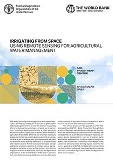Irrigating from space: how FAO-developed remote sensing technology can make a difference

©Shutterstock/lavizzara
There is no food without water. Yet, population growth, rising temperatures, and unpredictable weather—such as increased drought and floods—are threatening water resources across the globe.
Innovative digital solutions, like geospatial data, remote sensing, and the Internet of Things (IoT), provide real-time monitoring and data analysis for better decision-making in agricultural water management.
One example is the FAO-developed WaPOR—Water Productivity through Open Access of Remotely Sensed Derived Data Portal. With near real-time satellite data, this tool can help countries monitor agricultural water productivity, identify and reduce water productivity gaps, and calculate key parameters like actual water consumption. It can also be used to provide advice on irrigation water application or as an input to estimate economic irrigation water productivity.
The correct application of WaPOR, when combined with economic data, can lead to better policy and investment decisions on issues like water quotas, tariffs, or incentives for changing cropping patterns.
Irrigating from Space: Using Remote Sensing for Agricultural Water Management, a joint investment brief from FAO and the World Bank, takes a closer look at WaPOR. The brief benefited from FAO’s Land and Water Division’s expertise in crop mapping and evapotranspiration measurement, along with the Centre’s economic and policy analysis.
Using Lebanon’s Bekaa Valley as a case study, the brief’s authors applied a five-step methodology to calculate the economic irrigation water productivity for irrigated wheat and potato crops in three of the Valley’s governorates from the 2014/2015 to 2018/2019 seasons. This type of analysis can identify the best and worst-performing farms in terms of water consumption and productivity on farms growing the same crop (wheat or potatoes, in this case), helping design and target concrete improvement measures for specific locations.
Likewise, it provides data on the impact that the choice of crops and cropping systems have on water consumption and productivity—information that can inform policies on land use aimed at improving water productivity.
The analysis used for the Bekaa Valley can be applied to other water-deficient systems, contributing to water productivity assessments in data-scarce contexts. While the brief’s authors note that remote sensing cannot fully replace field observations, it can considerably reduce the frequency and cost of collecting field data.

